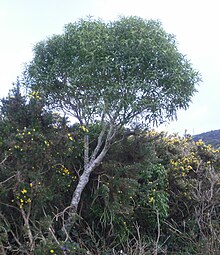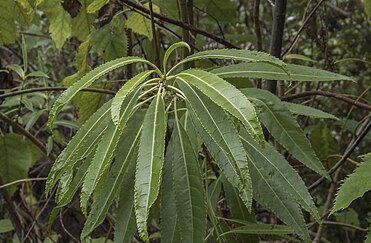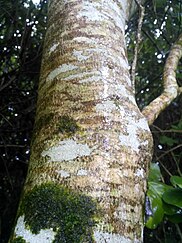| Melicytus lanceolatus | |
|---|---|

| |
| Conservation status | |
 Not Threatened (NZ TCS) | |
| Scientific classification | |
| Kingdom: | Plantae |
| Clade: | Tracheophytes |
| Clade: | Angiosperms |
| Clade: | Eudicots |
| Clade: | Rosids |
| Order: | Malpighiales |
| Family: | Violaceae |
| Genus: | Melicytus |
| Species: | M. lanceolatus |
| Binomial name | |
| Melicytus lanceolatus Hook.f. | |
Melicytus lanceolatus, commonly called narrow-leaved māhoe or māhoe-wao, is a small tree in the family Violaceae that is endemic to New Zealand.
Description
Melicytus lanceolatus is a small tree that typically appears slender, glabrous, and erect. Melicytus lanceolatus has the potential to grow up to 5–6 m tall with a trunk 30 cm in diameter.
The vibrant green leaves of M. lanceolatus are simple, alternate, and have a finely serrated margin. They are lanceolate in shape, being long, thin, and narrow. Typically, the leaves are 5–16 cm long by 0.5–2 cm wide. Occasionally, the tip of the leaf will curve downward. Overall, these features can make the leaves of M. lanceolatus look a lot like willow leaves.
Bark is brown to white, slightly wrinkled, and with prominent lenticels. Branches are brittle.
Flowers are small, 5 mm in diameter, and have five erect petals that curve backwards. Petal colours are variable, with some being yellow, dark purple, or with hints of both. Flowers occur in clusters of two to five. They grow along bare branches below leaves but occasionally from the leaf axils. These clusters can be in such high quantity that they densely cover the branch in small flowers. Flowers are scented, being fragrant day and night.
Melicytus lanceolatus produces dark purple round berries that are 4–6 mm in diameter. There is some discrepancy about the number of seeds in each berry, with some claiming between three and six seeds or six to twelve seeds.
-
 Leaves of Melicytus lanceolatus
Leaves of Melicytus lanceolatus
-
 Melicytus lanceolatus flowering in September
Melicytus lanceolatus flowering in September
-
 Trunk of Melicytus lanceolatus
Trunk of Melicytus lanceolatus
Range
Natural global range
Melicytus lanceolatus is endemic to New Zealand.
New Zealand range
Melicytus lanceolatus is found in the North Island, South Island and Stewart Island, from a latitude of 35°30S (Northland region) southwards from sea level to 915 m. In the South Island, it is mostly found around Dunedin, in Southland, and west of the Southern Alps. Although M. lanceolatus occurs on Stewart Island, it is not very common.
Habitat
This species prefers moist, cool areas with high rainfall from lowland up to montane forests. Melicytus lanceolatus is an early coloniser after a disturbance. It can be commonly seen growing along forest margins, in regenerating forest, or as a slightly shaded understory plant. Specifically, M. lanceolatus can be found in associations with red beech, silver beech, kāmahi, and tōtara forests. However, it can also occur in shrublands, river terraces, inland valleys or frosty basins.
Ecology
Phenology

Melicytus lanceolatus is a long-lived, dioecious plant. Flowering occurs from June to November (mid-winter or early spring to early summer) while fruiting occurs from July to February (late-winter to late-summer). Most fruits start to ripen from March to April. Insects are the primary pollinators of its flowers while frugivorous birds allow for seed dispersal. The seeds of M. lanceolatus were found to germinate after a two-month delay, often germinating in autumn or winter. Seeds could also remain viable in soil for up to thirty months.
Diet and foraging
It is tolerant of a range of soils except dry soils. It especially prefers being in a moist environment in high rainfall areas. Since it can be an understory plant, it can tolerate shade. However, it does require enough light to germinate, as seeds were found to have a very low germination rate (8%) in the dark. Since it prefers cool areas, M. lanceolatus has a cold sensitivity of –2.0 °C, but its leaves were found to endure frosts down to –8.3 °C.
Predators, Parasites, and Diseases
Due to its berries, flowers, and foliage, M. lanceolatus has interactions with insects, birds and introduced mammalian species.
Flies that have been caught visiting the flowers include fungus gnats from the family Sciaridae and Mycetophilidae, midges from the family Chironomidae, and hover flies, specifically the large hover fly.
Bees, as seen with the western honey bee, use the flowers as a pollen and nectar source.
Species of moth are also associated with M. lanceolatus. Pyrgotis plagiatana has been observed visiting its flowers. Austramathes purpurea caterpillars use this species as a host plant by feeding on its leaves. The caterpillars of the puriri moth use the tree as a host plant by burrowing into its trunk and eating the callus tissue produced. One of the indigenous names (although less commonly used) for M. lanceolatus, “Kaiwētā” (meaning “wētā food” in te reo Māori), suggests that wētā will also eat this plant. However, this could be in reference to the fact that wētā (specifically the tree wētā) live in holes made by the puriri moth, making it appear as though wētā eat trees like M. lanceolatus.

Bemisia flocculosa, also known as the Melicytus whitefly, use M. lanceolatus as a host plant by feeding on the underside of its leaves. This interaction occurs with other Melicytus species, hence the common name.
Thrips from the family Lathriidae have been caught visiting its flowers, while larvae from the species Hercinothrips bicinctus have been found infesting its leaves.
Melicytus lanceolatus is an attractive food source for birds. For example, New Zealand bellbirds eat the berries, while kererū eat the foliage, flowers, flower buds, and berries.
Introduced mammals such as red deer, fallow deer, white-tailed deer, and feral goats, also eat the foliage of M. lanceolatus.
Evolution
Melicytus lanceolatus has been described as one of the oldest Melicytus species. It was estimated to have diverged around 6.41 million years ago.
Etymology
The genus name Melicytus is derived from the Greek words μέλι (méli), meaning "honey," and κῠ́τος (kútos), meaning "hollow container." Combined, this literally means “honey cave,” referencing the nectaries below the stamens.
The species name lanceolatus is a Latin word meaning “shaped like a lance,” referencing the lanceolate leaves of M. lanceolatus.
Chromosome number
The chromosome number of M. lanceolatus is 2n = 32.
References
- de Lange, P. J; Rolfe, J. R; Barkla, J. W; Courtney, S; Champion, P. D; Perrie, L. R; Beadel, S. M; Ford, K; Breitwieser, I; Schönberger, I; Hindmarsh-Walls, R (2018). Conservation status of New Zealand indigenous vascular plants, 2017. Wellington, New Zealand: Department of Conservation. OCLC 1041649797.
- Nicol, E. R (1997). Common names of plants in New Zealand. Christchurch, New Zealand: Manaaki Whenua Press. ISBN 9780478093100. OCLC 38946767.
- ^ "Melicytus lanceolatus". New Zealand Plant Conservation Network. Retrieved 11 May 2024.
- "Melicytus lanceolatus Hook.f." Biota of New Zealand. Manaaki Whenua – Landcare Research. Retrieved 11 May 2024.
- Parsons, M.J; Macmillan, B.H; Douglass, P (1998). Current names list for wild gymnosperms, dicotyledons and monocotyledons (except grasses) in New Zealand : as used in Herbarium CHR. Christchurch, New Zealand: Manaaki Whenua Press. ISBN 9780478093193. OCLC 0478093195.
- ^ Cheeseman, T. F; Walter Reginald Brook, O (1925). Manual of the New Zealand flora (2nd ed.). Wellington, New Zealand: Government printer. OCLC 154288888.
- ^ Salmon, J. T (1986). The native trees of New Zealand (Rev ed.). Wellington, New Zealand: Heinemann Reed. ISBN 0790001047. OCLC 261361033.
- ^ Salmon, J. T (1991). Native New Zealand flowering plants. Auckland, New Zealand: Heinemann Reed. ISBN 079000223X. OCLC 26036266.
- ^ Wardle, J. A; Platt, I (2011). Wardle's native trees of New Zealand and their story. Wellington, New Zealand: New Zealand Farm Forestry Association. ISBN 978-1877520068. OCLC 759841801.
- ^ Metcalf, M. J (2006). Know your New Zealand trees. Auckland, New Zealand: New Holland. ISBN 1869660986. OCLC 144595167.
- ^ Dawson, J; Lucas, R (2012). A field guide to New Zealand's native trees. Nelson, New Zealand: Craig Potton. ISBN 978-1877517822. OCLC 816328841.
- ^ Allan, H. H (1961). Flora of New Zealand. Wellington, New Zealand: R.E. Owen, Government Printer. ISBN 0477010415. OCLC 977216383.
- ^ Eagle, A. L (2006). Eagle's complete trees and shrubs of New Zealand. Wellington, New Zealand: Te Papa Press. ISBN 9780909010089. OCLC 85262201.
- ^ Powlesland, M. H (1984). "Reproductive biology of three species of Melicytus (Violaceae) in New Zealand". New Zealand Journal of Botany. 22 (1): 81–94. doi:10.1080/0028825x.1984.10425235. ISSN 0028-825X.
- Cockayne, L (1909). Report on a botanical survey of Stewart Island. Wellington, New Zealand: J. Mackay, Government printer. OCLC 5379041.
- ^ Burrows, C. J (1996). "Germination behaviour of seeds of the New Zealand woody species Ascarina lucida, Coprosma grandifolia, Melicytus lanceolatus, and Solanum laciniatum". New Zealand Journal of Botany. 34 (4): 509–515. doi:10.1080/0028825x.1996.10410131. ISSN 0028-825X.
- Wardle, P (2002). Vegetation of New Zealand. Caldwell, New Jersey: Blackburn Press. ISBN 9781930665583. OCLC 57965892.
- Powlesland, M. H; Philipp, M; Lloyd, D. G (1985). "Flowering and fruiting patterns of three species of Melicytus (Violaceae) in New Zealand". New Zealand Journal of Botany. 23 (4): 581–596. doi:10.1080/0028825x.1985.10434229. ISSN 0028-825X.
- ^ Dale, E. E; Larcombe, M. J; Potter, B. C.; Lee, W. G (2022). "Diversification and trait evolution in New Zealand woody lineages across changing biomes". Journal of the Royal Society of New Zealand. 54 (1): 98–123. doi:10.1080/03036758.2022.2108071. ISSN 0303-6758. PMC 11459814.
- Bannister, P (2003). "Are frost hardiness ratings useful predictors of frost damage in the field? A test using damage records from the severe frost in South Otago and Southland, New Zealand, July 1996". New Zealand Journal of Botany. 41 (3): 555–569. doi:10.1080/0028825x.2003.9512869. ISSN 0028-825X.
- Butz Huryn, V. M (1995). "Use of native New Zealand plants by honey bees (Apis mellifera): A review". New Zealand Journal of Botany. 33 (4): 497–512. doi:10.1080/0028825x.1995.10410621. ISSN 0028-825X.
- Hoare, R (2017). Noctuinae (Insecta: Lepidoptera: Noctuidae) : part 1 : Austramathes, Cosmodes, Proteuxoa, Physetica. Christchurch, New Zealand: Manaaki Whenua Press. ISBN 9780947525095. OCLC 1016869674.
- Townsend, J. I (1997). An insect survey of Paengaroa Scenic Reserve, Mataroa. Wellington, New Zealand: Department of Conservation. OCLC 154151991.
- "Melicytus lanceolatus Hook.f." nzflora. Manaaki Whenua – Landcare Research. Retrieved 11 May 2024.
- ^ Wehi, P. M; Brownstein, G; Morgan-Richards, M (2020). "Indigenous plant naming and experimentation reveal a plant–insect relationship in New Zealand forests". Conservation Science and Practice. 2 (10). doi:10.1111/csp2.282. ISSN 2578-4854.
- Gill, R; Holder, P (2011). "A new species of Bemisia (Hemiptera, Aleyrodidae) from New Zealand". Zootaxa. 2794 (1): 63–68. doi:10.11646/zootaxa.2794.1.5.
- Martin, N. A. "Melicytus whitefly - Bemisia flocculosa". Interesting insects and other invertebrates. Manaaki Whenua – Landcare Research. Retrieved 11 May 2024.
- Martin, N. A; Mound, L. A. (2004). "Host plants for some New Zealand thrips (Thysanoptera: Terebrantia)". New Zealand Entomologist. 27 (1): 119–123. doi:10.1080/00779962.2004.9722133. ISSN 0077-9962.
- Emeny, M. T; Powlesland, R. G; Henderson, I. M; Fordham, R. A (2009). "Feeding ecology of kereru (Hemiphaga novaeseelandiae) in podocarp-hardwood forest, Whirinaki Forest Park, New Zealand" (PDF). New Zealand Journal of Ecology. 33 (2): 114–124. ISSN 1177-7788.
- Forsyth, D. M; Coomes, D. A; Nugent, G; Hall, G. M (2002). "Diet and diet preferences of introduced ungulates (Order: Artiodactyla) in New Zealand". New Zealand Journal of Zoology. 29 (4): 323–343. doi:10.1080/03014223.2002.9518316. ISSN 0301-4223.
- ^ Mitchell, A. D; Heenan, P. B; Murray, B. G; Molloy, B. P; de Lange, P. J (2009). "Evolution of the south-western Pacific genus Melicytus (Violaceae): evidence from DNA sequence data, cytology and sex expression". Australian Systematic Botany. 22 (3): 143–157. doi:10.1071/sb0804 (inactive 1 November 2024). ISSN 1030-1887.
{{cite journal}}: CS1 maint: DOI inactive as of November 2024 (link) - Scott, R; Liddell, H.G. (1889). An Intermediate Greek-English Lexicon. Oxford: Clarendon Press. OCLC 31899293. Retrieved 16 May 2024.
- Scott, R; Liddell, H. G. (1940). A Greek-English lexicon. Oxford: Clarendon Press. ISSN 1940-641X. OCLC 7547345129. Retrieved 16 May 2024.
- Poole, A. L; Adams, N. M (1994). West, C. J (ed.). Trees and shrubs of New Zealand (Rev ed.). Christchurch, New Zealand: Manaaki Whenua Press. ISBN 9780478045352.
- Lewis, C. T; Short, C (1879). A Latin Dictionary founded on Andrews' edition of Freund's Latin Dictionary revised, enlarged, and in great part rewritten. Oxford: Clarendon Press. OCLC 249321852. Retrieved 16 May 2024.
| Taxon identifiers | |
|---|---|
| Melicytus lanceolatus | |